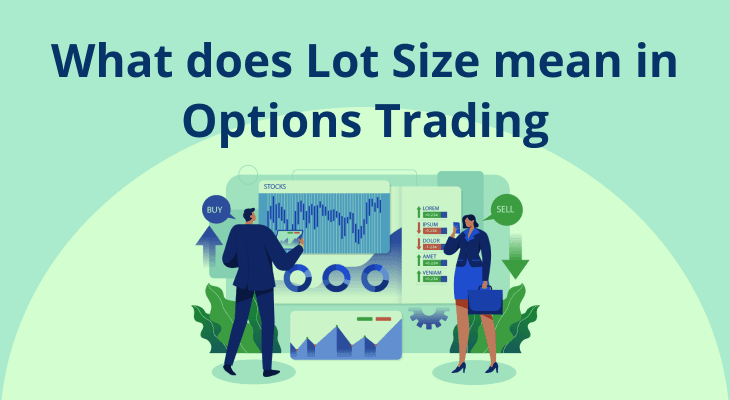
What Does Lot Size Mean In Options Trading?
Understanding Lot Size In Options Trading
When you begin exploring the world of derivatives, especially options trading, one term you’ll encounter frequently is “lot size”. In simple terms, the lot size refers to the minimum number of units (usually shares) of the underlying asset that you must trade in a single options contract. It is not possible to trade just one or two shares in the F&O (Futures and Options) segment, instead you trade in pre-defined bundles or “lots”.
The concept of lot size is vital because it directly influences your trading capital, exposure to market movement, and the overall structure of the options market. For traders, understanding how the lot size works in options is important to trading effectively, staying compliant with SEBI norms, and managing financial risk.
What Is Lot Size In Options Trading?
As mentioned earlier, lot size in options trading indicates the fixed number of units (shares) of the underlying asset represented in a single contract. If you're trading options on company X and the lot size is 300, you’re entering into a contract that covers 300 X shares.
To put it another way, the lot size sets the minimum quantity you must trade. If you want to increase your position, you may do so in multiples of the lot size (e.g. 2 lots = 600 shares).
Lot size ensures that all contracts on the exchange are standardised, thereby improving clarity and efficiency in the market. Whether you’re a new trader or an experienced one, the defined lot size keeps expectations uniform for all participants.
How Are Lot Sizes Determined?
The Securities and Exchange Board of India (SEBI) oversees the framework for futures and options trading. SEBI requires that the notional value of an F&O contract be not less than ₹ 15 lakh at the time of its introduction. Furthermore, the lot size is set so that the contract value remains in the range of ₹ 15 lakh to ₹20 lakh at the time of review.
Here’s how it works:
- Exchanges (such as NSE and BSE) calculate the lot size of a stock based on its prevailing market price.
- They divide the minimum notional value (₹15 - ₹20 lakh) by the market price to arrive at an appropriate lot size.
- Lot sizes are then rounded off to standard numbers like 25, 40, 75, 100, 125, etc., for ease of trading.
For example, if a stock trades at ₹ 1,250, then the minimum lot size = ₹15,00,000 ÷ ₹1,250 = ₹1,200 shares per lot. So, the lot size for options in that stock would be 1,200 shares.
The higher the share price, the smaller the lot size, and vice versa. This keeps the notional value in the desired range.
Why Do Lot Sizes Change?
Lot sizes are not static. They are revised periodically depending on the price movement of the underlying stock or index. The main reasons for changes are:
1. Price Volatility
If the market price of a stock rises significantly over time, the lot value may exceed the regulatory threshold (say ₹20 lakh). To bring it back to an acceptable range, SEBI and exchanges reduce the lot size. Conversely, if the price drops substantially, increasing the lot size helps maintain the minimum required value.
For example, a SEBI circular (dated October 1, 2024) raised the minimum notional value requirement for index derivatives, which led to a revision of lot sizes for key indices like Nifty 50 and Bank Nifty.
2. Corporate Actions
Events like stock splits, bonuses, and rights issues can impact lot sizes. Exchanges revise the lot size to reflect the changes in the number of outstanding shares.
3. Regulatory Updates
From time to time, SEBI may update the minimum notional value requirement (as it did in October 2024, raising it from ₹5 lakh to ₹15–₹20 lakh). Such changes prompt a review of lot sizes across eligible stocks and indices.
Purpose & Benefits Of Lot Sizes In Options Trading
Standardisation
Lot sizes help standardise F&O contracts across stocks and indices. Everyone trades in multiples of the same quantity, which simplifies contract terms, improves transparency, and reduces disputes.
Efficient Settlement
Uniform contract sizes streamline clearing and settlement processes for exchanges, brokers, and depositories. It becomes easier to manage positions and margins when trades occur in standard lots.
Liquidity Management
Having a consistent lot size across market participants supports better price discovery and tighter bid-ask spreads. It also encourages market makers to participate more actively.
Risk Control
By ensuring that the minimum notional value of each contract remains high, SEBI aims to discourage small retail investors from excessive speculative trading. This policy prevents many first-time traders from risking large sums without adequate understanding.
Impact Of Lot Sizes On Traders And Investors
Whether you’re trading full-time or investing occasionally, F&O lot size plays a crucial role in shaping your strategy.
Capital Requirement
Larger lot sizes mean you need more funds to take a position. For example, if the lot size for an option is 600 and the option premium is ₹90, you’d need ₹54,000 (600 × ₹ 90) to buy just one lot.
This makes F&O trading capital intensive, particularly for retail investors.
Position Sizing
Lot size restricts how precisely you can scale your position. If you want slightly more or less exposure, you have no choice but to increase or decrease by a whole lot.
Risk Management
Because you must trade in fixed multiples, your risk per trade also increases with the lot size. Larger lot sizes can lead to bigger profits or bigger losses.
Strategy Selection
Some strategies like straddles or spreads involve multiple options. You must consider the lot size to calculate margin requirements and potential gains/losses correctly.
How To Check The Lot Size Of A Stock or Index
Checking the minimum lot size in options is simple. Here are some reliable ways:
Visit The NSE or BSE Website
- Go to the “Derivatives” section.
- Under “Market Information” or “Product Information” look for F&O lot size data.
- You’ll find downloadable lists updated every time changes are announced.
Brokerage Platforms
Your trading platform typically displays the lot size of a stock when you open the options chain.
SEBI Circulars
Whenever there is a revision, SEBI publishes circulars specifying the changes in lot sizes. These can be accessed from its official website. Always double-check the lot size before placing any order to avoid costly errors.
Conclusion
A lot size for options is a key concept in derivatives trading. It dictates the minimum quantity you can buy or sell in any F&O contract. The lot size is determined by SEBI and stock exchanges to ensure standardisation, risk control, and smooth functioning of the markets.
As a trader, it is essential for you to stay informed about the current lot sizes and revisions, as these can significantly affect your trading capital, exposure, and strategy. Whether you’re hedging, speculating, or employing advanced strategies, understanding and factoring in the F&O lot size is non-negotiable. Always ensure you have adequate funds and clarity before entering a trade, and use official exchange sources to stay updated on changes.
Also Read: Options Trading Basics | Learn Calls, Puts & Market Strategies
FAQ
Can lot size vary across exchanges?
No, the lot size for options does not vary across exchanges. Both NSE and BSE follow SEBI’s guidelines, which standardise the F&O lot size. This helps ensure that traders face no confusion or mismatch in contract terms regardless of the platform they use.
Does futures lot size differ from options?
No. The lot size remains the same for both futures and options contracts for the same underlying asset.
How often are revisions made?
There is no fixed schedule for revising F&O lot sizes. However, SEBI and the exchanges review lot sizes whenever price movements or corporate actions (like stock splits) push the contract’s notional value outside the ₹ 15-20 lakh range.
What happens if I try to buy less than a full lot of options?
In the derivatives market, you cannot buy or sell fewer shares than the minimum lot size in options. Orders that do not match the exact lot size or its multiples will be automatically rejected by the trading system.
Can I adjust the lot size manually?
No, traders do not have the ability to change or customise the F&O lot size. The size is fixed by the exchange and is the same for every market participant.
Are index options and stock options lot sizes different?
Yes, index options (like Nifty or Bank Nifty) and stock options (like TCS or HDFC Bank) have different lot sizes. Each is determined based on the price of the underlying and the required notional value.
What is the reason behind fixing a minimum lot size in options?
SEBI sets a minimum lot size in options to reduce excessive speculation by retail investors and to maintain standardised trading. It ensures that traders take exposure only when they have adequate capital and understanding.
Does a stock split or bonus affect the lot size?
Yes, corporate actions like stock splits or bonuses may change the lot size for options. Exchanges revise the lot sizes in such cases to reflect the new share structure.
Where can I find the latest F&O lot sizes?
You can find the most up-to-date F&O lot size list on the official NSE website under the derivatives segment. Many brokers also provide updated lists in their platforms and trading websites.
Will SEBI change the notional value requirement in the future?
SEBI may review the notional contract value periodically, depending on market conditions, investor participation, and economic factors. If such a change occurs, it would directly impact the lot size for options.


